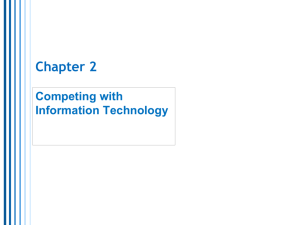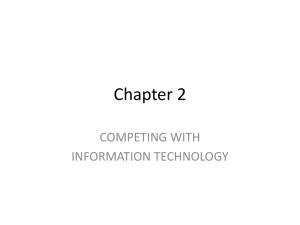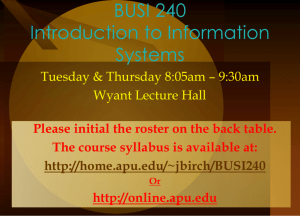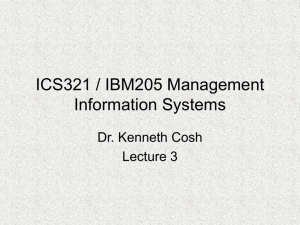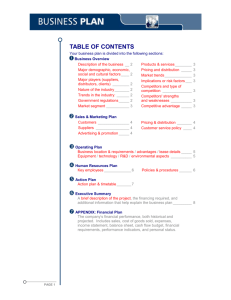Competing With Information Technology
advertisement
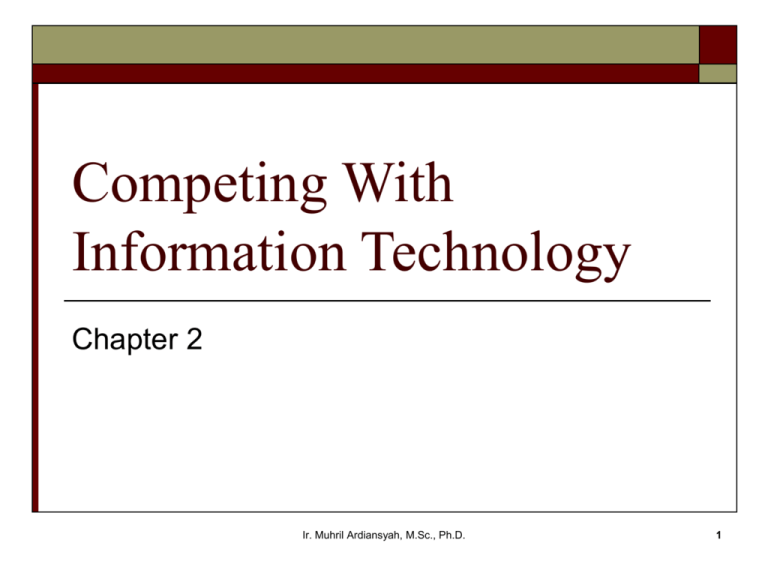
Competing With Information Technology Chapter 2 Ir. Muhril Ardiansyah, M.Sc., Ph.D. 1 http://misuisu.wordpress.com/ Ir. Muhril Ardiansyah, M.Sc., Ph.D. 2 Learning Objectives: Identify several basic competitive strategies and explain how they can use information technology to confront the competitive forces faced by a business. Ir. Muhril Ardiansyah, M.Sc., Ph.D. 3 Competitive Strategies: Competitive Strategies Cost Leadership Differentiation Other Strategies Innovation Growth Ir. Muhril Ardiansyah, M.Sc., Ph.D. Alliance 4 Competitive Forces: Competitive Forces Rivalry Of Competitors Threat Of New Entrants Bargaining Power Of Customers Ir. Muhril Ardiansyah, M.Sc., Ph.D. Bargaining Power Of Suppliers 5 Businesses Can Develop Competitive Strategies Cost Leadership Differentiation Innovation COMPETITIVE STRATEGIES Growth Alliance Other strategies Rivalry of competitors Threat of new entrants Threats of substitutes Bargaining power of customers Bargaining power of suppliers COMPETITIVE FORCES Ir. Muhril Ardiansyah, M.Sc., Ph.D. 6 Competitive Strategies Cost leadership strategy: becoming a low cost producer of products and services in the industry. Differentiation strategy: developing ways to differentiate a firm’s products and services from its competitors. Ir. Muhril Ardiansyah, M.Sc., Ph.D. 7 Competitive Strategies (continued) Innovation strategy: Finding new ways of doing business. Growth strategies: Significantly expanding a company’s capacity to produce goods and services. Alliance strategies: Establishing new business linkages and alliances with customers, suppliers, competitors, consultants, and other companies. Ir. Muhril Ardiansyah, M.Sc., Ph.D. 8 A Summary Of How Information Technology Can Be Used To Implement The Five Basic Competitive Strategies BASIC STRATEGIES IN THE BUSINESS USE OF INFORMATION TECHNOLOGY Lower Costs use IT to substantially reduce the cost of business processes. use IT to lower the costs of customers or suppliers. Differentiate develop new IT features to differentiate products and services. use IT features to reduce the differentiation advantages of competitors. use IT features to focus products and services at selected market. Innovate create new products and services that include IT components. develop unique new markets with the help of IT. make radical changes to business processes with IT that dramatically cut costs, improve quality, efficiency, customer services. Promote growth use IT to manage regional and global business expansion. use IT to diversity and integrate into other products and services. Develop alliance Ir. Muhril Ardiansyah, M.Sc., Ph.D. use IT to create virtual organizations of business partners. 9 Building A Customer Focused Business Strategic focus on “customer value”: recognizes that quality, rather than price has become the primary determinant in a customer’s perception of value. Ir. Muhril Ardiansyah, M.Sc., Ph.D. 10 Building A Customer Focused Business (continued). How A Customer Focused Business Builds Customer Value And Loyalty Using Internet Technologies Let customers place orders through distribution partners Let customers place orders directly Transaction Database Customer Database Give all employees a complete view of each customer Make loyal customers feel special with website personalization Let customers check order history and delivery status Ir. Muhril Ardiansyah, M.Sc., Ph.D. Link employees and distribution partners to database and customers 11 Becoming An Agile Company: Can make profit in markets with broad product ranges and short model lifetimes. Depend heavily on internet technologies. Ir. Muhril Ardiansyah, M.Sc., Ph.D. 12 Becoming An Agile Company (continued) Business must implement four basic strategies: 1. customers must perceive the products and services an agile company as solutions to their individual problems. 2. an agile company cooperates with: customers, suppliers, competitors, and other companies. Ir. Muhril Ardiansyah, M.Sc., Ph.D. 13 Becoming An Agile Company (continued) Business must implement four basic strategies (continued): 3. An agile company organizes so that it thrives on change. 4. An agile company leverages the impact of its people and the knowledge they posses. Ir. Muhril Ardiansyah, M.Sc., Ph.D. 14 Becoming An Agile Company (continued). How Information Technology Can Help A Company Be An Agile Competitors With The Help Of Customers And Business Partners Type Of Agility Description Role Of IT Customer Ability to co opt customers in the exploitation of innovation opportunities as sources of innovation ideas as co creators of innovations Technologies for building and enhancing virtual customer communities for product design, feedback, and testing Partnering Ability to leverage assets, knowledge, and competencies of suppliers, distributors in the exploration and exploitation of innovation opportunities Technologies facilitating inter firm collaboration, such as collaborative platforms and portals Operational Ability to accomplish speed, accuracy, and cost economy in the exploitation of innovation opportunities. Ir. Muhril Ardiansyah, M.Sc., Ph.D. Technologies for modularization and integration of business process 15 Creating A Virtual Company A virtual company: an organization that uses information technology to link people, organizations, assets, and ideas. Ir. Muhril Ardiansyah, M.Sc., Ph.D. 16 A Virtual Company Uses The Internet, Intranets, And Extranets To Form Virtual Workgroups And To Support Alliances With Business Partners Alliance with subcontractors Customer response and order fulfillment teams Alliance with a major suppliers Alliance with a major customer Extranets Manufacturing teams Alliance with small suppliers Engineering teams Alliance with a competitor Ir. Muhril Ardiansyah, M.Sc., Ph.D. 17 The Basic Business Strategies Of Virtual Companies Strategies Of Virtual Companies * Share infrastructure and risk with alliance partners * Link complementary core competencies * Reduce concept to cash time through sharing * Increase facilities and market coverage * Gain access to new markets and share market or customer loyalty Ir. Muhril Ardiansyah, M.Sc., Ph.D. 18 Real Word Case 2: GE Energy, Using Information Technology To Create Strategic Customer Relationships Look at General Electric (GE)’s power turbine business. Its customer are major utilities, and they have good reason to hate equipment failures. At the least, any downtime creates huge opportunity costs for the customers; often it means they have to pay hefty regulatory compliance fines. To reduce the risk, GE (and its competition) invests heavily information technologies for remote monitoring and diagnostics so it can deploy a technician or engineer ahead of a failure, Ir. Muhril Ardiansyah, M.Sc., Ph.D. 19 Real Word Case 2: GE Energy, Using Information Technology To Create Strategic Customer Relationships (continued) as opposed to doing so based upon a planned schedule, or assumptions about the maintenance needed by each type of turbine, or, even worse, after turbine fails and the power has gone off. This strategic investment in IT has a dramatic effect on the profitability of GE’s maintenance services. Most manufactures cannot charge more than $ 90 to $ 110 per hour for their technical support because of price and benefit pressures from local competitors. But GE Energy, because of its efficient network Ir. Muhril Ardiansyah, M.Sc., Ph.D. 20 Real Word Case 2: GE Energy, Using Information Technology To Create Strategic Customer Relationships (continued) Enabled remote servicing, can charge $ 500 to $ 600 per hour for the same technician. Even more important, the information generated by its continual monitoring allows GE to take an additional tasks, such as managing a customer’s spare parts inventory or providing the customer’s and GE’s service and support personnel with complete access to unified data and knowledge about the status of the equipment. Customer now look to GE not just for high quality energy equipment but also for help in optimizing their ability to supply consistent and high quality power to their customers. Ir. Muhril Ardiansyah, M.Sc., Ph.D. 21 Real Word Case 2: GE Energy, Using Information Technology To Create Strategic Customer Relationships (continued) So in fact, GE has created a significant amount of customer dependency for its services. This has allowed GE to tie its pricing to the business benefits it provides (power by the hour), for instance, rather than the products themselves. Ir. Muhril Ardiansyah, M.Sc., Ph.D. 22 Real Word Case 2: GE Energy, Using Information Technology To Create Strategic Customer Relationships (continued) What are the business benefits of using information technology to build strategic customer relationships for GE? What are the business benefits for their customers? How could other companies benefit from the use of IT to build strategic customer relationships? Provide or purpose several examples of such uses. Ir. Muhril Ardiansyah, M.Sc., Ph.D. 23 Discussian Questions: MIS author and consultant Peter Keen says: “We have learned that it is not technology that creates a competitive edge, but the management process that exploits technology.” What does he mean? Do you agree or disagree? Why? Ir. Muhril Ardiansyah, M.Sc., Ph.D. 24 http://misuisu.wordpress.com/ Ir. Muhril Ardiansyah, M.Sc., Ph.D. 25
